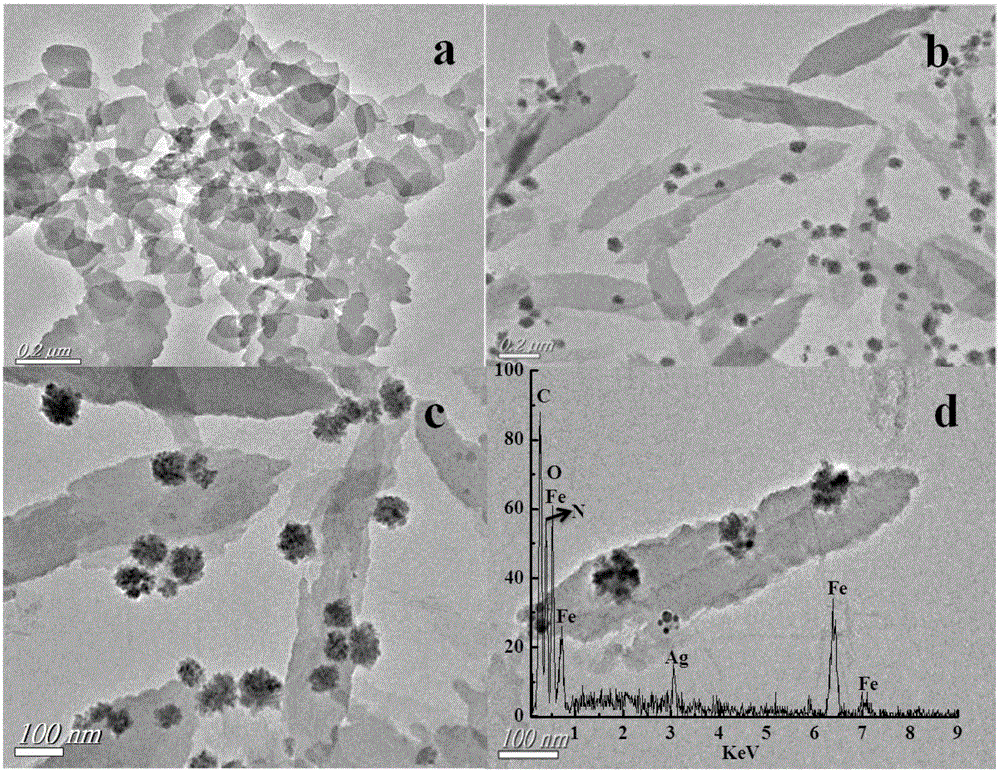Composite photocatalytic material, preparation method and application thereof
A technology of composite photocatalysis and magnetic composite materials, applied in chemical instruments and methods, physical/chemical process catalysts, chemical/physical processes, etc. It can solve the problems of morphology and other problems, and achieve the effect of enhancing light absorption and electron transfer, improving photocatalytic effect, and favorable photocatalytic effect.
- Summary
- Abstract
- Description
- Claims
- Application Information
AI Technical Summary
Problems solved by technology
Method used
Image
Examples
Embodiment 1
[0034] Step 1. Preparation of g-C 3 N 4 Photocatalyst: Put 5g of purchased melamine into a crucible, place it in a muffle furnace, and calcine it in an air atmosphere, raise the temperature to 500°C at a rate of 4°C / min, and keep it at a constant temperature for 2h, then directly from 500°C Raise the temperature to 520°C at a rate of 4°C / min, keep it at a constant temperature for 2 hours, and cool it down to room temperature naturally to obtain the product; take out the product and grind it finely, disperse the finely ground product in an alkaline solution and ultrasonically 0.5h, then wash to neutral, centrifuged, and calcined the separated product at 250°C for 2 hours, and took out the product after the calcination was completed and dropped to room temperature to obtain g-C 3 N 4 Photocatalyst, save for future use.
[0035] Step 2, preparation of Fe by hydrothermal deposition technology 3 o 4 / g -C 3 N 4 Composite material: 1.9 g of g-C prepared in step 1 3 N 4 Disp...
Embodiment 2
[0039] Step 1. Preparation of g-C 3 N 4 Photocatalyst: Put 5g of purchased melamine into a crucible, place it in a muffle furnace, and calcine it in an air atmosphere, raise the temperature to 500°C at a rate of 2.3°C / min, and keep it at a constant temperature for 2 hours, then directly from 500°C Raise the temperature to 520°C at a rate of 2.3°C / min, keep at a constant temperature for 2h, and cool down to room temperature naturally to obtain the product; take out the product and grind it finely, disperse the finely ground product in an alkaline solution for 1h, and then wash until Neutral, centrifuged, calcined the separated product at 150°C for 2 hours, and took out the product after the calcination was completed and dropped to room temperature, that is, g-C 3 N 4 Photocatalyst, save for future use.
[0040] Step 2, preparation of Fe by hydrothermal deposition technology 3 o 4 / g -C 3 N 4 Composite material: 0.8g of g-C prepared in step 1 3 N 4 Disperse in 20mL ethy...
Embodiment 3
[0044] Step 1. Preparation of g-C 3 N 4 Photocatalyst: Put 5g of purchased melamine into a crucible, place it in a muffle furnace, and calcine it in an air atmosphere, raise the temperature to 500°C at a rate of 3°C / min, and keep it at a constant temperature for 2h, then directly from 500°C Raise the temperature to 520°C at a rate of 3°C / min, keep it at a constant temperature for 2 hours, and cool it down to room temperature naturally to obtain the product; take out the product and grind it finely, disperse the finely ground product in an alkaline solution for 1 hour, and then wash until Neutral, centrifuged, calcined the separated product at 300°C for 2 hours, and took out the product after the calcination was completed and dropped to room temperature, that is, g-C 3 N 4 Photocatalyst, save for future use.
[0045] Step 2, preparation of Fe by hydrothermal deposition technology 3 o 4 / g -C 3 N 4 Composite material: 3 g of g-C prepared in step 1 3 N 4 Disperse in 40mL...
PUM
 Login to View More
Login to View More Abstract
Description
Claims
Application Information
 Login to View More
Login to View More - R&D
- Intellectual Property
- Life Sciences
- Materials
- Tech Scout
- Unparalleled Data Quality
- Higher Quality Content
- 60% Fewer Hallucinations
Browse by: Latest US Patents, China's latest patents, Technical Efficacy Thesaurus, Application Domain, Technology Topic, Popular Technical Reports.
© 2025 PatSnap. All rights reserved.Legal|Privacy policy|Modern Slavery Act Transparency Statement|Sitemap|About US| Contact US: help@patsnap.com



